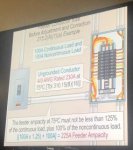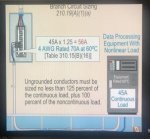I had a question on the wording of these slides. If you look at the branch circuit slide (both attached), the wording says “no less than 125% of continuous, plus 100% of noncontinuous.” If you look at the other slide, it’s the same wording (except 100 amps).
On one, you literally mean PLUS (addition +), the other you mean plus (in addition to, also). Is that correct? That’s according to the math you show on both too.
One is literally addition math, but the other could benefit wording like “no less than 125% of continuous load and also no less than 100% of the noncontinuous load.” That may avoid confusion on the 45A example.
I’m confirming I have my thought process correct, not correcting your work. Thank you!


On one, you literally mean PLUS (addition +), the other you mean plus (in addition to, also). Is that correct? That’s according to the math you show on both too.
One is literally addition math, but the other could benefit wording like “no less than 125% of continuous load and also no less than 100% of the noncontinuous load.” That may avoid confusion on the 45A example.
I’m confirming I have my thought process correct, not correcting your work. Thank you!



